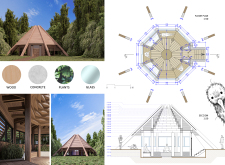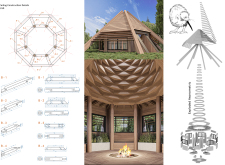5 key facts about this project
In terms of its architectural representation, "The Nest" symbolizes the balance between human experience and the natural world. Its primary function is to provide a space that fosters peace and introspection, allowing users to connect with their inner selves while being surrounded by nature. The project's layout incorporates an octagonal floor plan, which deviates from traditional rectangular designs, resulting in a fluid spatial configuration that enhances movement and engagement within the space.
Key elements of the design include wooden structural components that form both the walls and roof, promoting a warm and organic atmosphere. The roof rises to a peak, mimicking the upward thrust characteristic of a bird's nest, while also allowing natural light to permeate the interior. An integral part of the design, the wooden ceiling features intricate geometric patterns that evoke the honeycomb structure, reinforcing the principle of nature-inspired architecture. This unique ceiling design not only captivates the eye but also serves practical purposes, such as improving ventilation and allowing for the gathering of heat from the central bonfire.
Enhancing the relationship between the structure and its surroundings, "The Nest" incorporates transparent glass elements that open up the interior to the external landscape. The transparency provided by glass walls invites visual access to the natural environment, blurring the boundaries between the built structure and the outdoors. This connection is further emphasized through the inclusion of an inner garden, which integrates greenery into the meditation space, thus improving air quality and fostering a sense of tranquility.
The project utilizes a thoughtful selection of materials, with timber as the primary choice, reflecting a commitment to sustainability. This material not only aligns with ecological values but also contributes to the aesthetic and sensory experience of the space. The structural integrity provided by concrete elements ensures stability where necessary, yet these more industrial materials are balanced by organic touches to maintain the peaceful vibe of the design.
What sets "The Nest" apart is its innovative approach to spatial arrangement and materiality, incorporating cultural significance and ecological considerations into a cohesive design. The project reflects a deep understanding of the role architecture plays in enhancing mental well-being and environmental harmony. It serves as a model of how contemporary architecture can integrate with nature in a meaningful way, promoting mindfulness and meditation through its thoughtfully designed environment.
As you explore this project presentation further, consider examining the architectural plans, sections, and design elements to gain a deeper understanding of the creative principles that define "The Nest." The project stands as an example of how architectural ideas can be applied to create spaces that resonate emotionally and spiritually with users, inviting them into an experience that encourages connection with themselves and the natural world.


























